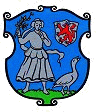Monheim am Rhein can look back on about 850 years of history since it was first mentioned in historic documents. A document from the year 1157 mentions a "willehelm de munheym" (Wilhelm von Monheim), who had agreed an exchange of land with the Gereonsstift (chapter of St. Gereon's church) in Cologne. A customs office is mentioned in 1257 and a brewery in 1262. A market is documented in the year 1307.
In ancient times, the townscape was much more strongly influenced by the Rhine than it is today. The course of the river repeatedly changed, leading to catastrophic consequences, until the embankment was built in 1929. Since an enormous flood in the 14th century, therefore, the former Roman fort of Haus Bürgel has no longer been on the left (western) side of the Rhine, but on the right (eastern) side.
For centuries, the territorial lords of Monheim were the counts (as of 1380: the dukes) of Berg. It was probably between 1350 and 1360 when the counts divided their territory into eight offices; one of them was the office of Monheim. In 1363, apart from Monheim and Baumberg, it included the districts of Hitdorf and Rheindorf (now a part of Leverkusen), Reusrath and Richrath (now part of Langenfeld), Urdenbach, Benrath, Himmelgeist, Itter, Holthausen, Wersten, Bilk and Hamm (now districts of Düsseldorf).
Between 1390 and 1408, Monheim was elevated to the rank of a “free town”, a town that governs itself – hence the name "Alte Freiheit" ("Old Freedom"), which is in common use today. Its elevation to the rank of a “free town” was probably due to Monheim’s strategic location: It lay between the areas controlled by counts of Berg and the archbishops of Cologne, an area full of conflicts. In 1275, Monheim had been fortified by Count Adolf VI in reaction to the fortification of Worringen by the archbishop.
Only a few years later – under pressure from his rival in Cologne – Adolf VI had to tear down the Monheim fortifications again. In 1415, Adolf VIII built a second fortification in Monheim; this one only lasted two years. The last fortification was built in 1423. The Schelmenturm, the "Rogue's Tower", still bears witness to it today.
After Napoleon founded the Confederation of the Rhine in 1806, the office of Monheim was dissolved. Along with Baumberg, Hitdorf and Rheindorf, Monheim became a municipality in the Grand Duchy of Berg founded under Napoleonic rule. Monheim became a community led by a mayor after the Rhineland was annexed to the Kingdom of Prussia by the Congress of Vienna in 1815.










![interner Link [intern]](https://www.monheim.de/typo3conf/ext/website_template/Resources/Public//Images/internal-link.png)




